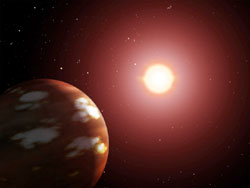This area deals with the fundamental laws and building blocks of nature and how they interact, the properties and the behavior of matter, and research into space and time and their structures.
innovations-report provides in-depth reports and articles on subjects such as astrophysics, laser technologies, nuclear, quantum, particle and solid-state physics, nanotechnologies, planetary research and findings (Mars, Venus) and developments related to the Hubble Telescope.

Space digest: September 2004
This release contains a summary of some significant astronomical and space events that will be taking place during September. It has been written in order to assist the media in planning and researching future stories related to space science and astronomy, particularly those with UK involvement. It is not intended to be fully comprehensive. Dates and times may be subject to change.
3 September: ISS Spacewalk
NASA Flight Engineer a

Were E.T. really interested in getting in touch with home, he might be better off writing than phoning, according to Christopher Rose, professor of electrical and computer engineering at Rutgers, The State University of New Jersey.
Rose contends that inscribing information and physically sending it to some location in deep space is more energy-efficient than pulsing it out on radio waves, which disperse as they travel.
“Think of a flashlight beam,” Rose says. “Its intensity d

Two new “Neptunes” are the smallest extra-solar planets yet—but could be the first of many
A team of astronomers has announced the discovery of some of the smallest planets yet detected beyond our solar system: two worlds that represent a new category of extra-solar planets, as well as significant and much-anticipated advance in the hunt for such objects.
Each of newly discovered planets is roughly comparable to the planet Neptune in our own solar system, says Geoffrey Marcy

Self-organizing synthetic molecules originally used for gene therapy may have applications as templates and scaffolds for the production of inorganic materials. Using electrostatic interactions between oppositely charged molecules as the binding force, scientists are learning how to organize these synthetic molecules into more versatile complexes with large and controllable pore sizes.
“By investigating the fundamental design rules for the control of self-assembled supramolecular str

Sharks are, by tradition, the eternal threat facing divers. Yet, a diver is quite a lot more unlikely to meet such a creature under the water than, at some time or another, to come up against an even greater danger – hypothermia, or exposure. To enable divers to prevent this syndrome from creeping silently up on them, two researchers from the Area of Applied Physics at the University Jaume I (Spain) have formulated an equation that enables divers to calculate the time they can safely remain submerge

Development phase completion of the European-built observation module, or “cupola”, for the International Space Station will be marked by a ceremony at the Alenia Spazio facility in Turin, Italy on Monday 6 September.
The cupola, currently scheduled for launch in January 2009, is an observation and control tower for the ISS, with windows that will provide a panoramic view for observing and guiding operations on the outside of the station.
The pressurised module will accommod